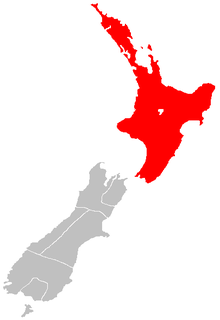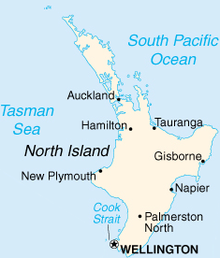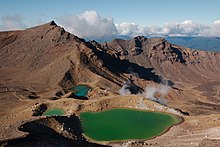North Island
Te Ika-a-Māui (Māori) | |
|---|---|
 | |
 North Island | |
| Geography | |
| Location | Oceania |
| Coordinates | 38°24′S 175°43′E / 38.400°S 175.717°E |
| Archipelago | New Zealand |
| Area | 113,729 km2 (43,911 sq mi) |
| Area rank | 14th |
| Highest elevation | 2,797 m (9177 ft) |
| Highest point | Mount Ruapehu |
| Administration | |
New Zealand | |
| ISO 3166-2:NZ | NZ-N |
| Regions | 9 |
| Territorial authorities | 43 |
| Largest settlement | Auckland (pop. 1,470,100) |
| Demographics | |
| Population | 3,896,200 (June 2020) |
| Pop. density | 34.3/km2 (88.8/sq mi) |
The North Island, also officially named Te Ika-a-Māui,[1] is one of the two main islands of New Zealand, separated from the larger but much less populous South Island by the Cook Strait. The island's area is 113,729 square kilometres (43,911 sq mi),[2] making it the world's 14th-largest island. It has a population of 3,896,200 (June 2020),[3] accounting for approximately 77% of the total residents of New Zealand.
Twelve main urban areas (half of them officially cities) are in the North Island. From north to south, they are Whangārei, Auckland, Hamilton, Tauranga, Rotorua, Gisborne, New Plymouth, Napier, Hastings, Whanganui, Palmerston North, and New Zealand's capital city Wellington, which is located at the south-west tip of the island.
Naming and usage[]
Although the island has been known as the North Island for many years,[4] in 2009 the New Zealand Geographic Board found that, along with the South Island, the North Island had no official name.[5] After a public consultation, the board officially named the island North Island or Te Ika-a-Maui in October 2013.[6]
In prose, the two main islands of New Zealand are called the North Island and the South Island, with the definite article.[7] It is also normal to use the preposition in rather than on, for example "Hamilton is in the North Island", "my mother lives in the North Island".[8] Maps, headings, tables, and adjectival expressions use North Island without "the".
Māori mythology[]
According to Māori mythology, the North and South Islands of New Zealand arose through the actions of the demigod Māui. Māui and his brothers were fishing from their canoe (the South Island) when he caught a great fish and pulled it from the sea. While he was not looking his brothers fought over the fish and chopped it up. This great fish became the North Island and thus a Māori name for the North Island is Te Ika-a-Māui ("The Fish of Māui").[9] The mountains and valleys are believed to have been formed as a result of Māui's brothers' hacking at the fish. Until the early 20th Century, Aotearoa was an alternative Māori name for the North Island. In present usage, Aotearoa is a collective Māori name for New Zealand as a whole.
Geography[]

Bays and coastal features[]
- Bay of Islands
- Bay of Plenty
- Hauraki Gulf
- Hawke Bay
- Ninety Mile Beach
- North Taranaki Bight
- South Taranaki Bight
Lakes and rivers[]
Capes and peninsulas[]
Forests and national parks[]
- Egmont National Park
- Tongariro National Park
- Waipoua Kauri Forest
- Whanganui National Park
- and many forest parks of New Zealand
Volcanology[]
Other[]
- Waitomo Caves
- Taumatawhakatangihangakoauauotamateaturipukakapikimaungahoronukupokaiwhenuakitanatahu
Demographics[]
The North Island has an estimated population of 3,896,200 as of June 2020.[3]
Ever since the conclusion of the Otago Goldrush in the 1860s, New Zealand's European population growth has experienced a steady 'Northern drift' as population centres in the North Island have grown faster than those of New Zealand's South Island. This population trend has continued into the twenty-first century, but at a much slower rate. While the North Island population continues to grows faster than the South Island, this is solely due to the North Island having higher natural increase (i.e. births minus deaths) and international migration; since the late 1980s, the internal migration flow has been from the North Island to the South Island.[10] In the year to June 2020, the North Island gained 21,950 people from natural increase and 62,710 people from international migration, while losing 3,570 people from internal migration.[11]
Culture and identity[]
At the 2018 New Zealand census, 65.7% of North Islanders identified as of European ethnicity, 18.5% as Māori, 17.0% as Asian, 9.7% as Pacific Peoples, 1.6% as Middle Eastern/Latin American/African, and 1.2% as another ethnicity (mainly 'New Zealander'). Totals add to more than 100% since people may identify with multiple ethnicities.[12]
The proportion of North Islanders born overseas is 29.3%. The most common foreign countries of birth are England (15.4% of overseas-born residents), Mainland China (11.3%), India (10.1%), South Africa (5.9%), Australia (5.5%) and Samoa (5.3%).[13]
Cities and towns[]

The North Island has a larger population than the South Island, with the country's largest city, Auckland, and the capital, Wellington, accounting for nearly half of it.
There are 28 urban areas in the North Island with a population of 10,000 or more:
| Name | Population (June 2020)[3] |
% of island |
|---|---|---|
| Auckland | 1,470,100 | 37.7% |
| Wellington | 215,100 | 5.5% |
| Hamilton | 176,500 | 4.5% |
| Tauranga | 151,300 | 3.9% |
| Lower Hutt | 110,700 | 2.8% |
| Palmerston North | 81,500 | 2.1% |
| Napier | 66,300 | 1.7% |
| Porirua | 59,600 | 1.5% |
| New Plymouth | 57,600 | 1.5% |
| Rotorua | 58,500 | 1.5% |
| Whangārei | 54,400 | 1.4% |
| Hibiscus Coast | 59,800 | 1.5% |
| Hastings | 49,000 | 1.3% |
| Upper Hutt | 44,300 | 1.1% |
| Whanganui | 42,200 | 1.1% |
| Gisborne | 37,000 | 0.9% |
| Paraparaumu | 30,100 | 0.8% |
| Pukekohe | 26,500 | 0.7% |
| Taupō | 25,400 | 0.7% |
| Masterton | 21,400 | 0.5% |
| Cambridge | 20,500 | 0.5% |
| Levin | 18,800 | 0.5% |
| Feilding | 17,050 | 0.4% |
| Whakatāne | 16,700 | 0.4% |
| Havelock North | 14,900 | 0.4% |
| Tokoroa | 14,300 | 0.4% |
| Te Awamutu | 13,100 | 0.3% |
| Waikanae | 13,650 | 0.4% |
Economy[]
The sub-national GDP of the North Island was estimated at US$102.863 billion in 2003, 79% of New Zealand's national GDP.[14]
Governance[]
Regions[]

Nine local government regions cover the North Island and its adjacent islands and territorial waters.
- Northland
- Auckland
- Waikato
- Bay of Plenty
- Gisborne
- Taranaki
- Manawatū-Whanganui
- Hawke's Bay Region
- Wellington Region
Healthcare[]
Healthcare in the North Island is provided by fifteen District Health Boards (DHBs). Organised around geographical areas of varying population sizes, they are not coterminous with the Local Government Regions.
See also[]
References[]
- ^ Staff Reporter (10 October 2013). "Two official options for NZ island names". The New Zealand Herald. Retrieved 20 December 2018.
- ^ "Quick Facts – Land and Environment : Geography – Physical Features". Statistics New Zealand. 2000. Archived from the original on 8 April 2013. Retrieved 13 August 2012.
- ^ Jump up to: a b c "Population estimate tables - NZ.Stat". Statistics New Zealand. Retrieved 22 October 2020.
- ^ On some 19th-century maps, the North Island is named New Ulster, which was also a province of New Zealand that included the North Island.
- ^ "The New Zealand Geographic Board Considers North and South Island Names". Land Information New Zealand. 21 April 2009. Archived from the original on 14 February 2013. Retrieved 28 November 2012.
- ^ "Two official options for NZ island names". The New Zealand Herald. 10 October 2013. Retrieved 10 October 2013.
- ^ Williamson, Maurice (11 October 2013). "Names of NZ's two main islands formalised". Beehive.govt.nz. New Zealand Government. Retrieved 10 April 2020.
- ^ Guardian and Observer style guide: N ("New Zealand"), The Guardian. Retrieved 15 April 2019
- ^ "1000 Māori place names". New Zealand Ministry for Culture and Heritage. 6 August 2019.
- ^ "New Zealand's population is drifting north". 26 January 2015. Archived from the original on 26 January 2015. Retrieved 22 February 2021.
- ^ "Subnational population component changes and median age (RC, TA), at 30 June 2018-20 (2020 boundaries)". nzdotstat.stats.govt.nz. Retrieved 18 February 2021.
- ^ "Ethnic group (detailed total response - level 3) by age and sex, for the census usually resident population count, 2006, 2013, and 2018 Censuses (RC, TA, SA2, DHB)". nzdotstat.stats.govt.nz. Retrieved 3 March 2020.
- ^ "Birthplace (detailed), for the census usually resident population count, 2006, 2013, and 2018 Censuses (RC, TA, SA2, DHB)". nzdotstat.stats.govt.nz. Retrieved 18 February 2021.
- ^ "Regional Gross Domestic Product". Statistics New Zealand. 2007. Archived from the original on 20 May 2010. Retrieved 18 February 2010.
External links[]
 Media related to North Island, New Zealand at Wikimedia Commons
Media related to North Island, New Zealand at Wikimedia Commons North Island travel guide from Wikivoyage
North Island travel guide from Wikivoyage
- North Island
- Islands of New Zealand


